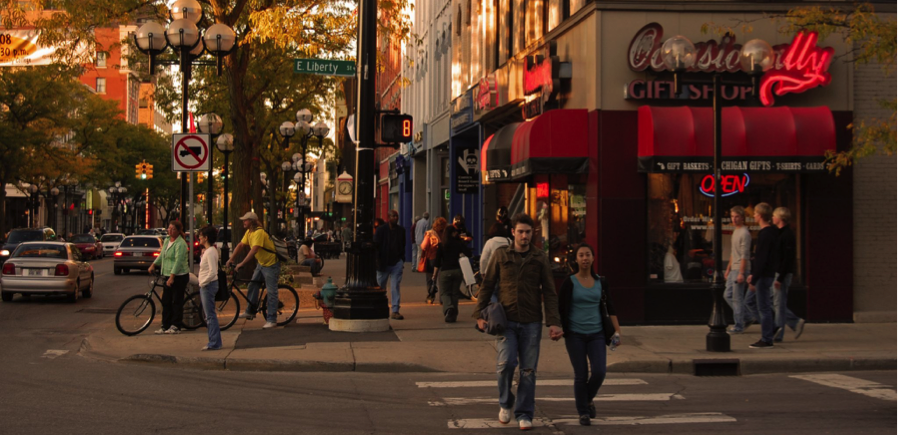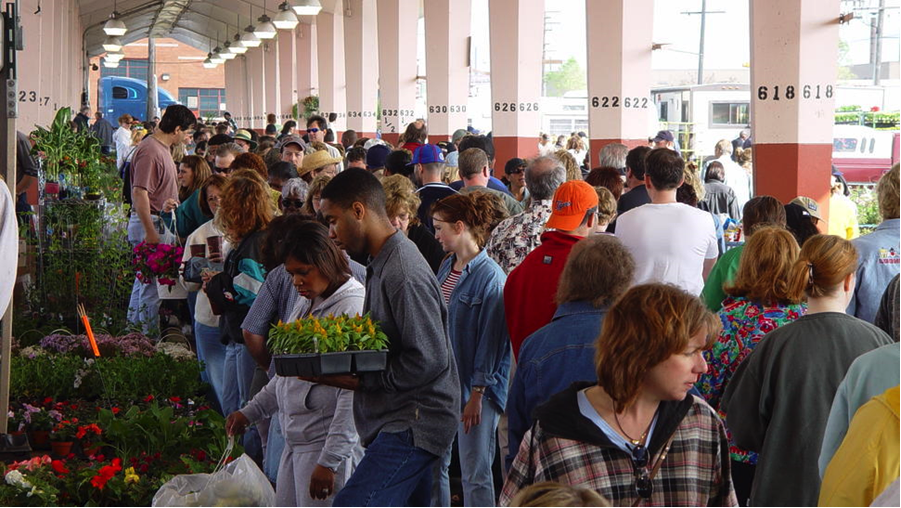Tours require an additional fee. You can add tours during the registration process. Please check back for updates on AIA and AICP credits.
This day-long tour explores Grand Rapids, Michigan, a city in the midst of a grand transition from auto-oriented to urban paradise. The city boasts a compact and walkable downtown core with a surprising collection of historic prewar architecture along a once-forgotten riverfront. Today, redevelopment is attracting retail and residents back to the urban core and the diverse close-in neighborhoods are buzzing with activity.
Popularly known as Beer City USA, Grand Rapids also boasts a thriving craft brewing sector. Tour participants will witness firsthand how these establishments have catalyzed new development and reignited neighborhood night life. The tour will range across several historic neighborhoods, along with one of the largest urban historic districts in America and several new infill projects that have changed the urban fabric of the city. Participants can connect with West Michigan New Urbanists and get acquainted with one of the most livable mid-sized cities in the Midwest. This tour will include walking through diverse neighborhoods, over a river, and around downtown—so bring your walking shoes and camera.
Breakfast and dinner are included in the tour cost. Lunch will be on your own.
Join us on a walking tour of downtown Detroit’s rich history, architecture and public places. Tour participants will explore some of the great contributions of notable architects and experience the 1805 Baroque hexagonal plan laid out by Judge Woodward. Detroit's architecture is recognized as being among the finest in the U.S. with one of the largest surviving collections of late-19th- and early-20th-century buildings. The National Trust for Historic Preservation lists many of Detroit's skyscrapers and buildings as some of America's most endangered landmarks.

Downtown Ann Arbor is a place with unique character, different from other cities in Michigan and the Midwest. Its attractiveness is largely derived from the diversity of residents – 43,000 University of Michigan students and 117,000 permanent residents covering a wide range of professions, ethnicities, and ages.
CNU Founder Peter Calthorpe’s 2005 report for the Downtown Development Strategies Project takes an integrated approach to balancing economic development, land use, environment, accessibility/mobility, and urban design. This tour will showcase the improvements made to design, housing opportunities, and multimodal transit infrastructure in Ann Arbor, as well as the integration of the University of Michigan campus into the urban fabric. Participants will make a stop at the world famous Zingerman's Deli for an opportunity to grab lunch or a snack on their own.
Dive deep into Detroit’s music heritage on this four-hour, mission-driven Detroit music heritage tour. From Paradise Valley to United Sound Systems, experience historic districts and reflect on the challenges and opportunities involved in preserving Detroit’s musical legacy.
Tour participants will break out of downtown to explore music-related spaces in Detroit’s West Side, East Side, Woodward Corridor, North End, New Center, Cass Corridor, and Midtown neighborhoods, plus Highland Park and Hamtramck. This tour is designed to not just teach participants about the bebop history of the Blue Bird Inn and the house parties of Detroit’s North End, but to also shift their gears from musical observation to sonic activism—making this tour an essential experience both for savvy visitors and Metro-Detroit cultural allies.
Detroit Music Experience Tour is sponsored by Key Public Strategies.

Described as one of the most beautiful architectural destinations in the World, Cranbrook has been one of the nation’s leading graduate schools of art, architecture, and design since its conception by newspaper mogul George Booth in 1928. Some of the world’s most renowned architects, designers, and artists—including Eliel and Eero Saarinen, Edmund Bacon, Charles and Ray Eames, and Katherine McCoy—have called Cranbook home.
Located on over 300 acres, the campus had evolved by the 1940s into what Saarinen called a “historic document” of his developing sense of “American” architecture. More than 70 outdoor sculptures by world-renowned sculptor and faculty member Carl Milles complement Saarinen's architecture. Many resident artists, as well as those commissioned by Booth and Saarinen's architecture. Many resident artists, as well as those commissioned by Booth and Saarinen, designed Cranbook’s gates, light fixtures, and interior furnishings. In the twentieth century, the work emanating from Cranbrook changed the way people live and the way they understand art and design.
The tour will include Cranbrook’s noted schools, museums, homes and plazas including the Kingswood School, the Upper School, Graduate Architectural Studio, Science Center and Art Museum.
In the first half of the 20th century, Detroit was called “The Paris of the West” and “The Arsenal of Democracy.” Booming industry and a rapidly expanding population quickly elevated Detroit to the fourth largest city in the country. Building upon a L’Enfant-inspired hexagonal grid, enigmatic architecture designed by the nation’s prominent architects arose throughout the core city. A 10-story department store, a comprehensive streetcar system, unrivaled arts and entertainment districts, endless employment opportunities, and the spirit of invention defined and characterized Detroit’s peak years.
Yet despite the great feats of early industrial Detroit, auto-mobilization and suburbanization quickly and dramatically altered the course of the Motor City. Piercing highways, self-contained buildings, pervasive parking, infamous demolitions, widened roadways, and urban renewal left Detroit as the poster-child for rust belt cities.
This walking tour of Detroit’s core will explore both eras of urban planning in Detroit. Participants will learn about projects, buildings, and stories of urban evolution and devolution unique to Detroit. Equal parts visual and oral history, this tour is a must-see for experiencing Detroit in 2016.
Join us on a walking tour of downtown Detroit’s rich history, architecture and public places. Tour participants will explore some of the great contributions of notable architects and experience the 1805 Baroque hexagonal plan laid out by Judge Woodward. Detroit's architecture is recognized as being among the finest in the U.S. with one of the largest surviving collections of late-19th- and early-20th-century buildings. The National Trust for Historic Preservation lists many of Detroit's skyscrapers and buildings as some of America's most endangered landmarks.
Travel along Cass Avenue and explore a neighborhood in the midst of a renaissance. The Cass Corridor was once notorious as a red-light district plagued by crime and drugs. Now, through dedicated work by Midtown Detroit Inc., various local institutions, and concerned citizens, Cass Avenue has transformed into Midtown, a neighborhood that offers thriving retail, restaurant, and residential uses in a walkable environment. Residents enjoy cultural amenities such as the Detroit Institute of Arts, Detroit Historical Museum, and Charles H. Wright Museum of African American History all within walking distance of their homes.
Director of Midtown Detroit Inc. Sue Mosey will guide participants along Cass Avenue to see many of the changes that have occurred. Starting at the Masonic Temple, participants will see projects such as Cass Plaza, a residential building saved from the wrecking ball; the Iconic Building, a redeveloped commercial center representing one of the last pieces of Detroit’s Chinatown; and the Auburn, a new construction multiuse building that embraces local businesses. The tour will also feature stops at notable new retailers Shinola and Carhartt, and iconic architectural gems like the McGregor Memorial Conference Center at Wayne State University and the Fisher Building in New Center. There will also be a small break at Avalon International Breads for coffee and baked goods.
In the first half of the 20th century, Detroit was called “The Paris of the West” and “The Arsenal of Democracy.” Booming industry and a rapidly expanding population quickly elevated Detroit to the fourth largest city in the country. Building upon a L’Enfant-inspired hexagonal grid, enigmatic architecture designed by the nation’s prominent architects arose throughout the core city. A 10-story department store, a comprehensive streetcar system, unrivaled arts and entertainment districts, endless employment opportunities, and the spirit of invention defined and characterized Detroit’s peak years.
Yet despite the great feats of early industrial Detroit, auto-mobilization and suburbanization quickly and dramatically altered the course of the Motor City. Piercing highways, self-contained buildings, pervasive parking, infamous demolitions, widened roadways, and urban renewal left Detroit as the poster-child for rust belt cities.
This walking tour of Detroit’s core will explore both eras of urban planning in Detroit. Participants will learn about projects, buildings, and stories of urban evolution and devolution unique to Detroit. Equal parts visual and oral history, this tour is a must-see for experiencing Detroit in 2016.
#MovetoDetroit became a popular hashtag soon after artist, poet, and performer Patti Smith declared that New York City had "closed itself off" to the young and struggling and suggested artists find a new city - like Detroit - to inhabit. But 2010 was far from the birth of the art scene in Detroit.
Experience the Detroit art scene firsthand with a guided tour by Lynn Crawford, fiction writer and art critic. Go beyond the mainstream media reports to explore the depth and diversity of art being made and seen in Detroit. From locally-owned galleries to MOCAD to the Dabl's African Bead Gallery, this tour will provide attendees with a deeper knowledge of the role art plays in Detroit today.
Take a hardhat tour of the Wurlitzer Building, a previously abandoned 14-story property constructed in 1926 that is being restored and repurposed into a 106-key boutique hotel. Tour leaders ASH NYC recently opened the Dean Hotel in Providence and are currently in development of a 71-key hotel in the Marigny neighborhood of New Orleans. Learn about the economic trends that drove this small development group into boutique hotel development, the product and brand that has been informed by these trends, the future of these trends, and why Detroit, and specifically the Wurlitzer building, was perfectly positioned for the expansion of ASH NYC’s hospitality portfolio.
Tour the primary developments within the Downtown core, Midtown, and New Center districts, including the Guardian Building, Riverwalk, New Center, and Woodbridge, to name a few. This approximately 12-square mile area has seen dramatic changes over the last few years with thousands of new residents, dozens of new businesses, hundreds of retails spaces and restaurants, and billions of dollars of new investment. See firsthand the redevelopment of these areas including both private and public enhancements, as well as major infrastructure improvements.
Lafayette Park, Detroit’s first Urban Renewal project, is a Modernist mixed-use development situated immediately east of Detroit's Central Business District. In contrast to other projects completed in the United States under the Urban Renewal program, Lafayette Park is generally regarded as a success, due in part to the level of attention paid to site planning, architecture, and landscape design. These elements were, in fact, produced by some of the notable practitioners of the time: Mies van der Rohe served as architect for the initial phase of the development, and Lafayette Park contains the world’s largest collection of Mies buildings occupying a single site.
Intended to bring the quiet and spacious suburban lifestyle into the urban core, Lafayette Park was planned within walking distance of entertainment and employment. The site has been preserved to a degree rarely achieved, allowing visitors to experience the development in a state of maturity in-sync with the designers’ original vision. The National Park Service recognized it as a National Historic Landmark in 2015. This walking tour will allow participants to experience Lafayette Park from the viewpoint of a 26 year resident while receiving an overview of its history from conception to completion and beyond. The tour will include the interior of a residential unit in the high-rise 1300 tower (A later addition to Lafayette Park designed by Gunnar Birkerts [1961-1964]) as well as a townhouse residential unit designed by Mies.
Learn how Detroit became a food sovereign city while exploring community gardens, farm plots, orchards, and a cut-flower farm. Participants will travel by bus to three different neighborhoods to experience the adaptability of agriculture to an urban setting.
Take in views of downtown Detroit while wandering through the Plum Street Market Garden. Learn about nationally-recognized programs including the Garden Resource Program (GRP) and Grown in Detroit (GID) operated by the staff of Keep Growing Detroit (KGD). Visit the Georgia Street Community Collective, on Detroit's East Side, to experience a five lot, non-profit garden including a fruit orchard and community center. Finally, explore the two-farm plot of Jefferson Chalmers Community Food Systems, in the Jefferson Chalmers Neighborhood. The first plot is “The Garden”, a 12-acre farm and CSA program that provides organically grown local produce to 40 local families; while the second plot, "Detroit Abloom", produces and markets specialty cut flowers.

Eastern Market, Detroit’s beloved public market district, has been serving up great food and conviviality since 1891. Since 2006, the nonprofit Eastern Market Corporation has managed and operated the market under an agreement with the City of Detroit. More than $40 million has been invested in market capital improvements and district infrastructure upgrades. In 2015, EMC launched its 2025 Development Strategy focused on equitable development, public realm enhancement, and organizational capacity building. The goals for 2025 are centered on expanding the market’s local diversity and regional food enterprise, while maintaining the authenticity of the place as a place for genuine economic democracy.
Eastern Market is already one of the nation’s most comprehensive regional food hubs, and EMC’s goal is to become even more inclusive, robust, and resilient while continuing to nourish Detroit. Bike over to the market on Saturday morning to experience the market for yourself. Supporting the local economy is encouraged.
Market Day at Detroit's Eastern Market Tour is sponsored by SmithGroupJJR.
This tour will include approximately 3 miles of biking. Please dress appropriately.
Explore the West Village and Indian Village Neighborhoods of Detroit on foot while learning about Missing Middle Housing. We’ll document Missing Middle Housing types, such as duplexes, fourplexes, and multiplexes, and complete photographic and sketch documentation, while discussing the following: location of types within blocks and neighborhoods; typical lot sizes and associated densities; and unit sizes and layout of rooms. In addition, we’ll discuss the important role of these types in providing diverse housing choices and revitalizing Detroit’s neighborhoods. This exercise will leave you with the tools and knowledge to explore, recognize and document other Missing Middle Housing throughout Detroit or in your community. We’ll take public transit to the location and back, likely sharing a cold drink at one of the local establishments to wrap up the discussions.
Interested in further exploring the Missing Middle in Detroit? Join the launch at CNU 24 to start building a database of MMH:
- Tweet or Insta photos of great Missing Middle Housing examples you find in Detroit with hashtags: #MissingMiddle #Detroit #CNU24
- Use our survey to contribute great examples to the new Missing Middle Housing map. Find links to the survey and more about these efforts at missingmiddlehousing.com/cnu24!
All Saturday tours depart from The Fillmore, 2115 Woodward. Please meet in front of the marquee.
Dara O'Byrne, Deputy Director, Land Use & Policy, Detroit Future City Daniel Parolek, AIA, Principal, Opticos Design, Inc. Karen Parolek, Principal, Opticos Design, Inc Cailin Shannon, Senior Designer, Opticos Design, Inc

Old Sandwich Towne is one of the oldest established communities in all of Ontario and the setting of many historically significant events. This diverse history includes links to First Nations, Black, French and British settlements.
Sandwich Town played a major role in the shaping of the current community and country. Sandwich Towne was first settled in 1749 as a French agricultural settlement, making it the oldest continually inhabited settlement in Canada west of Montreal. It also played a very important role in the War of 1812. Today, this neighborhood stands as the Sandwich Heritage Conservation District, one of only two designated neighborhoods in the City of Windsor. Many buildings and houses date to the mid-19th century.
As part of the commercial and civic section of Sandwich Town, Sandwich Street is quite distinct architecturally from other districts in Windsor. Many of the buildings in Sandwich Towne exhibit Classical Revival, Georgian, and Tudor influences in their roof forms, timber detailing, brick exteriors, and window and door styles. These architectural styles can be identified in prominent buildings such as the Duff-Baby Mansion (1798), the McGregor-Cowan House (1806), Jules-Robinet Winery Building (1895), Sandwich Towne Hall (1912), the Sandwich Post Office (1906), Mackenzie Hall (1855) and St. John’s Church (1871).
Participate in a leisurely 4 kilometer bicycle ride through Windsor’s Riverfront park system adjacent to the historic Detroit River, followed by a walking tour to discover numerous buildings of interest in the historic Sandwich neighborhood. Discuss the evolution of the Town’s streets, the unique architectural features of the building structures, the prominent residents that worked and lived in each, and how they played an important role in shaping this community. A focus will placed on its resurgence and future, including the redevelopment and repurposing of some of the buildings in the area.
* Participants coming from Detroit will depart by bus one hour prior to the start times listed above, and return to Detroit one hour after the listed end times. Passports are required for this tour. *
Described as one of the most walkable downtowns in the Midwest, Birmingham has successfully implemented innovative urban planning since the 1920s, beginning with the City Beautiful movement. Today, the historic streetcar city has become one of Detroit’s most desirable suburbs.
Although the city has a small population of 20,000, it has over three million square feet of commercial property and a transect of urban building types. For the past 20 years, the city has been implementing Andres Duany’s 2016 Master Plan, one of America’s pioneering form-based codes. Walk the historic downtown core, the City Beautiful Civic Park, and multiple residential and commercial districts for a true Birmingham experience. Noted mixed-use buildings, parking structures, civic art, and traffic calming measures will be illustrated.


















